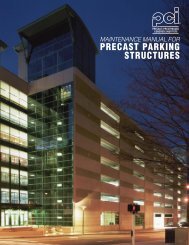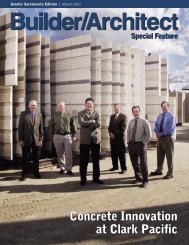Designers Notebook - Stone Veneer-Faced Precast part 1
Designers Notebook - Stone Veneer-Faced Precast part 1
Designers Notebook - Stone Veneer-Faced Precast part 1
- No tags were found...
Create successful ePaper yourself
Turn your PDF publications into a flip-book with our unique Google optimized e-Paper software.
ocks, such as granite, mayTypical Flat Moldor may not exhibit relativelyuniform strength characteristicson the variousplanes. In addition, theFlat Mold For Natural <strong>Stone</strong>Little or no additional costsurface finish, freezing andthawing, and large temperaturefluctuations will affect Clearances built in formface for natural stonethe strength and in turn handling deviceReturn Mold For Natural <strong>Stone</strong>influence the anchorageAdditional mold<strong>Stone</strong> must be held in placesystem.cost for backformingandwith clamps or disposable(galv./St. Stl.) threadedInformation on thedaily labor tofasteners (at joints) that areattach stoneremoved after each pour,durability of the specifiedto return wallleaving a threaded wingassembly embedded in thestone should be obtainedconcrete panelthrough current testing inconjunction with observationsof existing installa-Fig. 2 Moldstions of that <strong>part</strong>icular stone. This information should include such factors as tendency towarp, reaction to weathering forces, resistance to chemical pollutants, resistance to chemicalreaction from adjacent materials and reduction in strength from the effects of weathering orwetting and drying.Prior to awarding the precast concrete contract, tests should be performed to determinethe physical properties of the stone being considered. The testing should be done on stonewith the same finish and thickness to be used on the structure. Flexural tests (ASTM C880)should be used to evaluate the physical properties and obtain design values. Absorptiontesting (ASTM C97) helps evaluate freeze-thaw durability. These properties, along withproperties of the anchor system, should be used to ensure adequate strength of the panelto resist loads during handling, transportation, erection and in-service conditions.42<strong>Stone</strong> Sizes<strong>Stone</strong> veneers used for precast facing are usually thinner than those used for conventionallyset stone, with the maximum size generally determined by the stone strength. Table 1summarizes typical dimensions. <strong>Veneer</strong>s thinner than those listed can result in anchors beingreflected on the exposed surface, excessive breakage or permeability problems.The length and width of veneer materials should be sized to a tolerance of +0 – 1/8 inch, sincea plus tolerance can present problems on precast concrete panels. This tolerance becomesimportant when trying to line up the false joints on one panel with those on the panel above orbelow, <strong>part</strong>icularly when there are a large number of pieces of stone on each panel. Tolerance




